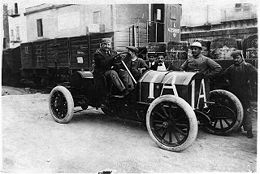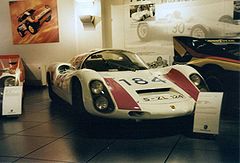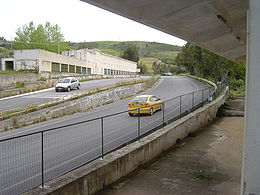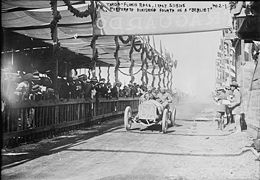- Targa Florio
-
The Targa Florio was an open road endurance automobile race held in the mountains of Sicily near Palermo. Founded in 1906, it was the oldest sports car racing event, part of the World Sportscar Championship between 1955 and 1973. While the first races consisted of a whole tour of the island, the track length in the race's last decades was limited to the 72 kilometres (45 mi) of the Circuito Piccolo delle Madonie, which was lapped 11 times.
After 1973, it was a national sports car event until it was discontinued in 1977 due to safety concerns. It has since been run as a rallying event, and is part of the Italian Rally Championship.
Contents
History
 Vincenzo Lancia driving a Fiat 50 hp in 1908 Targa Florio, finished 2nd.
Vincenzo Lancia driving a Fiat 50 hp in 1908 Targa Florio, finished 2nd.
The race was created in 1906 by the wealthy pioneer race driver and automobile enthusiast, Vincenzo Florio, who had started the Coppa Florio race in Brescia, Lombardy in 1900.
One of the toughest competitions in Europe, the first Targa Florio covered 3 laps equalling 277 miles (446 km) through multiple hairpin curves on treacherous mountain roads, at heights where severe changes in climate frequently occurred. Alessandro Cagno won the inaugural 1906 race in nine hours, averaging 30 miles per hour (50 km/h).
By the mid-1920s, the Targa Florio had become one of Europe's most important races, as neither the 24 Hours of Le Mans nor the Mille Miglia had been established yet. Grand Prix races were still isolated events, not a series like today's F1.
The wins of Mercedes (not yet merged with Benz) in the 1920s made a big impression in Germany, especially that of German Christian Werner in 1924, as he was the first non-Italian winner since 1920. Rudolf Caracciola repeated a similar upset win at the Mille Miglia a couple of years later. In 1926, Eliska Junkova, one of the great female drivers in Grand Prix motor racing history, became the first woman to ever compete in the race.
In 1953, the FIA World Sportscar Championship was introduced. The Targa became part of it in 1955, when Mercedes had to win 1-2 with the Mercedes-Benz 300 SLR in order to beat Ferrari for the title. They had missed the first two of the 6 events, Buenos Aires and the 12 Hours of Sebring, where Ferrari, Jaguar, Maserati and Porsche scored. Mercedes appeared at and won in the Mille Miglia, then pulled out of Le Mans as a sign of respect for the victims of the 1955 Le Mans disaster, but won the Tourist Trophy at Dundrod. Stirling Moss/Peter Collins and Juan Manuel Fangio/Karl Kling finished minutes ahead of the best Ferrari and secured the title.
Over the years, the greats of Grand Prix racing and Formula One such as Argentina's Juan Manuel Fangio, Belgium's Olivier Gendebien and Britain's Stirling Moss came to challenge Italian champions Tazio Nuvolari, Alfieri Maserati, Achille Varzi and others, like local hero Nino Vaccarella.
Several versions of the track were used. It started with a single lap of a 148 km (92 mi) circuit from 1906-1911 and 1931. From 1912 to 1914 an entire tour along the perimeter of Sicily was done, with a single lap of 606 miles (975 km), lengthened to 671 miles (1,080 km) from 1948 to 1950. The 148 km "Grande" circuit was then shortened twice, the first time to 67 mi (108 km), the version used from 1919-1930, and then to the 72 km (45 mi) circuit used from 1932 to 1977.
The start and finish took place at Cerda. The counterclockwise lap lead from Caltavuturo and Collesano from an altitude over 600 metres (1,970 ft) down to sea level, where the cars raced from Campofelice di Roccella on the Buonfornello straight along the coast, a straight over 6 km (3.7 mi) longer than the Mulsanne straight at the Circuit de la Sarthe in Le Mans. The longest version of the circuit went south through Caltavuturo (whereas the shortest version of the open-road circuit went east through Caltavuturo, through a mountainous section to Collesano) through an extended route through elevation changes, and swept through the nearby towns of Castellana and Sottana, twisting around mountains up to the town of Castelbuono and rejoined the most recent version of the track at Collesano. The second version of the track also went south through Caltavuturo and took a shortcut starting right before Castellana to Collesano via the town of Polizzi Generosa.
The race cars were started one by one every two minutes for a time trial, as a start from a full grid was not possible on the tight and twisty roads. Helmut Marko set the lap record in 1972 in an Alfa Romeo 33TT3 at 33 min 41 s at an average of 128.253 km/h (79.693 mph) during an epic charge where he made up 2 minutes on Arturo Merzario and his Ferrari 312PB.[1] The fastest ever was Leo Kinnunen in 1970, qualifying the Porsche 908/3 at 128.571 km/h (79.890 mph) or 33 min 36 s.[2]
Due to the track's length, drivers practised in the week before the race in public traffic, often with their race cars fitted with license plates. Porsche factory drivers even had to watch onboard videos, a sickening experience for some. The lap record for the 146km "Grande" circuit was 2 hours 3 min 54.8 seconds set by Achille Varzi in a Bugatti Type 51 at the 1931 race at an average speed of 70.7 km/h (43.931 mph).[3] The lap record for the 108 km "Medio" circuit was 1 hour 21 min 21.6 seconds set by Varzi in an Alfa Romeo P2 at an average speed of 79.642 km/h (49.487 mph) at the 1930 race. [4] The fastest completion around the short version of the island tour was done by Ernesto Ceirano in a SCAT at the 1914 race, completed in 16 hours, 51 minutes and 31.6 seconds from May 24-25, 1914.[5]. The fastest completion of the long version of the island tour was by Mario and Franco Bornigia in an Alfa Romeo 8C 2500, completed in 12 hours, 26 minutes and 33 seconds flat at the 1950 race at an average speed of 86.794 km/h (53.931 mph). [6]
In the late 1960s and early 1970s, race cars with up to 600 hp (450 kW) such as Nino Vaccarella's Ferrari 512S raced through small mountain villages while spectators sat or stood right next to, or even on, the road. Porsche, on the other hand, did not race its big Porsche 917, but rather the nimble Porsche 908/03 Spyders.
Due to safety concerns, especially by Helmut Marko, who called the race "totally insane", the last real Targa Florio as an international professional race was run in 1973. In that year, even a Porsche 911 won as the prototypes such as Jacky Ickx's Ferrari suffered crashes or other troubles. The Targa was continued as a national event for some years, before a fatal crash sealed its fate in 1977. It has since run as a rallying event.
Legacy
After winning the race several times, Porsche named the convertible version of the 911 after the Targa. The name targa means plaque, see targa top.
The Australian made Leyland P76 car had a special version named Targa Florio named to commemorate victory in the race in 1974.[7]
The event has lent its name to a number of road rallies such as Targa Tasmania.
A stunning recreation of the track was made for the race simulator Grand Prix Legends, which has been converted to rFactor.
Winners
Pre-WWI races
Year Winner Car Time Distance (km) Speed (km/h) Laps Course Variant 1906  Alessandro Cagno
Alessandro Cagno Itala 35/40 HP
Itala 35/40 HP9:32:22 446.469 46.80 3 Grande Circuit (146 km) 1907  Felice Nazzaro
Felice Nazzaro Fiat 28/40 HP
Fiat 28/40 HP8:17:36 446.469 53.83 3 Grande Circuit (146 km) 1908  Vincenzo Trucco
Vincenzo Trucco Isotta Fraschini
Isotta Fraschini7:49:26 446.469 57.06 3 Grande Circuit (146 km) 1909  Francesco Ciuppa
Francesco Ciuppa SPA
SPA2:43:19 148.823 54.67 1 Grande Circuit (146 km) 1910  Tullio Cariolato
Tullio Cariolato Franco Automobili
Franco Automobili6:20:47 297.646 46.90 2 Grande Circuit (146 km) 1911  Ernesto Ceirano
Ernesto Ceirano SCAT
SCAT9:32:22 446.469 46.80 2 Grande Circuit (146 km) 1912  Cyril Snipe
Cyril Snipe SCAT 25/35
SCAT 25/3524:37:19 979.000 41.44 1 Island Tour (short) (979 km) 1913  Felice Nazzaro
Felice Nazzaro Nazzaro Tipo 2
Nazzaro Tipo 219:18:40 979.000 50.70 1 Island Tour (short) (979 km) 1914  Ernesto Ceirano
Ernesto Ceirano SCAT 22/32
SCAT 22/3216:51:31 979.000 58.07 1 Island Tour (short) (979 km) Between the Wars
Year Winner Car Time Distance (km) Speed (km/h) Laps Course Variant 1919  André Boillot
André Boillot Peugeot EXS
Peugeot EXS7:51.01.8 432 - 4 Media Circuit (108 km) 1920  Guido Meregalli
Guido Meregalli Nazzaro GP
Nazzaro GP8:27.23.8 432 50.924 4 Media Circuit (108 km) 1921  Giulio Masetti
Giulio Masetti Fiat 451
Fiat 4517:25'05.2 432 58.236 4 Media Circuit (108 km) 1922  Giulio Masetti
Giulio Masetti Mercedes GP/14
Mercedes GP/146:50.50.2 432 63.091 4 Media Circuit (108 km) 1923  Ugo Sivocci
Ugo SivocciAlfa Romeo RL Targa Florio 7:18.00.2 432 59.177 4 Media Circuit (108 km) 1924  Christian Werner
Christian WernerMercedes PP 6:32.37.2/5 432 66.010 4 Media Circuit (108 km) 1925  Bartolomeo Costantini
Bartolomeo CostantiniBugatti T35 7:32.27.2 540 71.609 5 Media Circuit (108 km) 1926  Bartolomeo Costantini
Bartolomeo CostantiniBugatti T35T 7:20.45.0 540 73.507 5 Media Circuit (108 km) 1927  Emilio Materassi
Emilio MaterassiBugatti T35C 7:35.55.4 540 71.065 5 Media Circuit (108 km) 1928  Albert Divo
Albert DivoBugatti T35B 7:20.56.6 540 73.478 5 Media Circuit (108 km) 1929  Albert Divo
Albert DivoBugatti T35C 7:15'41.7 540 74.366 5 Media Circuit (108 km) 1930  Achille Varzi
Achille VarziAlfa Romeo P2 6:55.16.6 540 78.010 5 Media Circuit (108 km) 1931  Tazio Nuvolari
Tazio NuvolariAlfa Romeo 8C-2300 Monza 9:00'27.0 584 64.834 4 Grande Circuit (146 km) 1932  Tazio Nuvolari
Tazio NuvolariAlfa Romeo 8C-2300 Monza 7:15.50.6 574 79.296 8 Piccolo Circuit (72 km) 1933  Antonio Brivio
Antonio BrivioAlfa Romeo 8C-2300 Monza 7:15.50.6 504 76.729 7 Piccolo Circuit (72 km) 1934  Achille Varzi
Achille VarziAlfa Romeo Tipo-B P3 6:14'26.8 432 69.222 6 Piccolo Circuit (72 km) 1935  Antonio Brivio
Antonio BrivioAlfa Romeo Tipo-B P3 2:08.47.2 432 80.010 6 Piccolo Circuit (72 km) 1936  Constantino Magistri
Constantino MagistriLancia Augusta 6:14'26.8 144 67.088 2 Piccolo Circuit (72 km) 1937  Giulio Severi
Giulio SeveriMaserati 6CM 2:55'49.0 315.6 107.704 60 Closed Circuit (5.26 km) 1938  Giovanni Rocco
Giovanni RoccoMaserati 6CM 1:30'04.6 171.6 114.303 30 Closed Circuit (5.72 km) 1939  Luigi Villoresi
Luigi VilloresiMaserati 6CM 1:40.15.4 228 136.445 40 Closed Circuit (5.7 km) 1940  Luigi Villoresi
Luigi VilloresiMaserati 4CL 1:36.08.6 228 142.288 40 Closed Circuit (5.7 km) Post-WW II races
Year Winner Car Time Distance (km) Speed (km/h) Laps Course Variant 1948  Clemente Biondetti/Igor Troubetzkoy
Clemente Biondetti/Igor TroubetzkoyFerrari 166 12:12'00.0 1080 88.866 1 Island Tour (long) (1080 km) 1949  Clemente Biondetti/Aldo Benedetti
Clemente Biondetti/Aldo BenedettiFerrari 166 SC 13:15.09.4 1080 81.494 1 Island Tour (long) (1080 km) 1950  Mario Bornigia/Giancarlo Bornigia
Mario Bornigia/Giancarlo BornigiaAlfa Romeo 6C 2500 Competizione 12:26.33.0 1080 86.794 1 Island Tour (long) (1080 km) 1951  Franco Cortese
Franco CorteseFrazer Nash 7:31.04.8 576 76.631 8 Piccolo Circuit (72 km) 1952  Felice Bonetto
Felice BonettoLancia Aurelia B20 7:11.58.0 576 76.631 8 Piccolo Circuit (72 km) 1953  Umberto Maglioli
Umberto MaglioliLancia D20 3000 7:08.35.8 576 80.635 8 Piccolo Circuit (72 km) 1954  Piero Taruffi
Piero TaruffiLancia D 24 6:24.18.0 576 89.930 8 Piccolo Circuit (72 km) World Championship races
Year Winner Car Time Distance (km) Speed (km/h) Laps Course Variant 1955 Stirling Moss/Peter Collins Mercedes-Benz 300SLR 9:43.14.0 936 96.290 13 Piccolo Circuit (72 km) 1956 Umberto Maglioli/Huschke von Hanstein Porsche 550 7:54.52.6 720 90.770 10 Piccolo Circuit (72 km) 1957 Fabio Colona Fiat 600 - 359 - 5 Piccolo Circuit (72 km) 1958 Luigi Musso/Olivier Gendebien Ferrari 250TR 10:37.58.1 1008 94.801 14 Piccolo Circuit (72 km) 1959 Edgar Barth/Wolfgang Seidel Porsche 718 RSK 11:02.21.8 1008 91.309 14 Piccolo Circuit (72 km) 1960 Jo Bonnier/Hans Herrmann/Graham Hill Porsche 718 RS60 7:33.08.2 720 95.320 10 Piccolo Circuit (72 km) 1961 Wolfgang von Trips/Olivier Gendebien Ferrari Dino 246SP 6:57.39.4 720 103.433 10 Piccolo Circuit (72 km) 1962 Willy Mairesse/Ricardo Rodriguez/Olivier Gendebien Ferrari Dino 246SP 7:02'56.3 720 102.143 10 Piccolo Circuit (72 km) 1963 Jo Bonnier/Carlo Maria Abate Porsche 718 GTR Coupé 6:55.45.1 720 109.908 10 Piccolo Circuit (72 km) 1964 Colin Davis/Antonio Pucci Porsche 904 GTS 7:10.53.3 720 100.258 10 Piccolo Circuit (72 km) 1965 Nino Vaccarella/Lorenzo Bandini Ferrari 275P2 7:01:12.4 720 102.563 10 Piccolo Circuit (72 km) 1966 Willy Mairesse/Herbert Müller Porsche 906 Carrera 6 [9] 7:16:32.6 720 98.910 10 Piccolo Circuit (72 km) 1967 Paul Hawkins/Rolf Stommelen Porsche 910 [10] 6:37.01.0 720 108.812 10 Piccolo Circuit (72 km) 1968 Vic Elford/Umberto Maglioli Porsche 907 6:28:47.9 720 111.112 10 Piccolo Circuit (72 km) 1969 Gerhard Mitter/Udo Schütz Porsche 908/2 6:07:45.3 720 117.469 10 Piccolo Circuit (72 km) 1970 Jo Siffert/Brian Redman Porsche 908/3 [11] 6:35.30.0 792 120.152 11 Piccolo Circuit (72 km) 1971 Nino Vaccarella/Toine Hezemans Alfa Romeo 33/3 6:35:46.2 792 120.070 11 Piccolo Circuit (72 km) 1972 Arturo Merzario/Sandro Munari Ferrari 312PB 6:27:48.0 792 122.537 11 Piccolo Circuit (72 km) 1973 Herbert Müller/Gijs van Lennep Porsche 911 Carrera RSR [12] 6:54:20.1 792 114.691 11 Piccolo Circuit (72 km) - The 1957 race was not a race but a regularity test, following the Mille Miglia accident.
Non-WC races
- 1974 : Gérard Larrousse/Amilcare Ballestrieri, Lancia Stratos
- 1975 : Nino Vaccarella/Arturo Merzario, Alfa Romeo 33 TT 12
- 1976 : Armando Floridia, Osella
- 1977 : Raffaele Restivo, Chevron
 Porsche 910 2.0 coupé inside the Porsche Museum in Stuttgart Zuffenhausen. #184 and Stuttgart license plate "S-ZL 124" indicate the car was chassis 910-006 driven at the 1967 Targa Florio by Umberto Maglioli and Udo Schütz
Porsche 910 2.0 coupé inside the Porsche Museum in Stuttgart Zuffenhausen. #184 and Stuttgart license plate "S-ZL 124" indicate the car was chassis 910-006 driven at the 1967 Targa Florio by Umberto Maglioli and Udo Schütz
 Porsche 911 Carrera RSR, winner 1973
Porsche 911 Carrera RSR, winner 1973
Wins by make
The list below includes all car manufacturers who have attained a podium. The table does not include the results of the 1957 edition, which was held as a regularity race.
Pos. Brand 1st
place2nd
place3rd
placeFastest
laps1  Porsche
Porsche11 9 12 8 2  Alfa Romeo
Alfa Romeo10 13 7 10 3  Ferrari
Ferrari7 6 4 7 4  Lancia
Lancia5 7 5 4 5  Bugatti
Bugatti5 4 5 6 6  Maserati
Maserati4 6 9 4 7  Mercedes-Benz
Mercedes-Benz3 2 1 4 8  SCAT
SCAT3 0 0 0 9  Fiat
Fiat2 3 3 2 10  Nazzaro
Nazzaro2 0 0 0 11  Itala
Itala1 2 1 1 12  Osella
Osella1 1 1 2 13  Peugeot
Peugeot1 1 1 1 14  Chevron
Chevron1 1 0 0 15  SPA
SPA1 0 1 1 16  Franco
Franco1 0 0 1 17  Isotta Fraschini
Isotta Fraschini1 0 0 0 17  Frazer-Nash
Frazer-Nash1 0 0 0 19  Ballot
Ballot0 1 1 0 19  Cisitalia
Cisitalia0 1 1 0 19  De Vecchi
De Vecchi0 1 1 0 22  Osca
Osca0 1 0 1 23  Aquila Italiana
Aquila Italiana0 1 0 0 23  Sigma
Sigma0 1 0 0 25  Lola
Lola0 0 1 1 26  Abarth
Abarth0 0 1 0 26  Alfa-Maserati-Prete
Alfa-Maserati-Prete0 0 1 0 26  Berliet
Berliet0 0 1 0 26  Darracq
Darracq0 0 1 0 26  Diatto
Diatto0 0 1 0 26  Steyr
Steyr0 0 1 0 32  Aston Martin
Aston Martin0 0 0 1 See also
Further reading
- Valenza, Giuseppe (2007). Targa Florio Il Mito: Legenda Editore (Italy). ISBN 88-88165-17-7.
References
- ^ "56th Targa Florio 1972". formula2.net. http://www.formula2.net/Targa72.htm. Retrieved 2008-07-13.
- ^ "Leo Kinnunen". forix.autosport.com. http://forix.autosport.com/8w/kinnunen.html. Retrieved 2008-07-13.
- ^ "Targa Florio 1931". Formula2.net. 2001-08-26. http://www.formula2.net/Targa31.htm. Retrieved 2011-10-18.
- ^ "Targa Florio 1930". Formula2.net. http://www.formula2.net/Targa30.htm. Retrieved 2011-10-18.
- ^ "1914 Targa Florio - The AUTOSPORT Bulletin Board". Forums.autosport.com. http://forums.autosport.com/index.php?showtopic=12863&mode=linearplus. Retrieved 2011-10-18.
- ^ "Targa Florio 1950". Formula2.net. http://www.formula2.net/Targa50.htm. Retrieved 2011-10-18.
- ^ "The Leyland P76 a brief history". Themotorreport.com.au. 2008-06-09. http://www.themotorreport.com.au/5085/the-real-mccoy-on-the-leyland-p76-giving-it-the-boot. Retrieved 2011-05-12.
- ^ "F2 Register - Index". Formula2.net. http://www.formula2.net/index.html. Retrieved 2011-10-18.
- ^ "Race report". Imca-slotracing.com. http://www.imca-slotracing.com/QUIZZ2.htm. Retrieved 2011-05-12.
- ^ "Race report". Imca-slotracing.com. http://www.imca-slotracing.com/1967-PART2.htm. Retrieved 2011-05-12.
- ^ Race report 54th TARGA FLORIO
- ^ Race report TARGA FLORIO (ROUND #6)
External links
- Targa Florio History
- Targappassionati
- Porsche at Targa Florio
- Targa Florio memorabilia
- Museo Biblioteca Vincenzo Florio a Campofelice di Roccella - www.targaflorio-1906-1977.it
- http://www.targapedia.com
- The full Targa Florio for GrandPrix Legends
- http://www.amicidellatargaflorio.com
Coordinates: 37°56′52″N 13°47′10″E / 37.94778°N 13.78611°E
Categories:- Sports car races
- World Sportscar Championship races
- Auto races in Italy
- Recurring sporting events established in 1906
Wikimedia Foundation. 2010.


